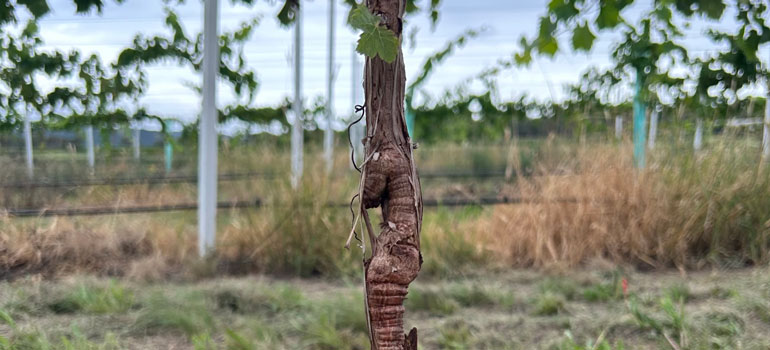Growers are being asked to remain vigilant for symptoms of crown gall disease, after a number of vineyards across Australia have reported symptoms in vines in recent months.
What is crown gall?
Crown gall is a significant plant disease. It is caused by two types of bacteria: Agrobacterium and Allorhizobium, which cause tumour-like growths (galls) on many plants, including grapevines.
Agrobacterium and Allorhizobium species are commonly found in soil and water all around the world, living independently of host plants. However, once a plant becomes infected, the bacterium can become a pathogen that causes disease.
Early symptoms of the disease in grapevines include gall formation at the sites of vine wounds (including grafting and pruning points), stunted vine growth and peeling and cracking of bark.

Image courtesy AWRI.
Symptoms of vines that have had gall for longer include declining vine vigour and eventual vine death. Young vines are particularly vulnerable as galls can impede water and nutrient flow throughout the vine.
See some examples of the symptoms in this AWRI e-Bulletin (22 February 2024) and view the AWRI factsheet (March 2024). The February editions of VineWatch from NSW DPI also contain useful information.
Where is it present?
The current outbreak of crown gall-like symptoms appears to be isolated to a limited number of vineyards in Queensland, New South Wales, South Australia and Victoria.
Agrobacterium from the biovar 1 group has been implicated, but pathogenicity testing is ongoing, and further identification is required to determine the specific strain (or combination of strains) that is causing symptoms.
At this stage, it remains unclear whether the disease outbreak originated from infected planting material, environmental factors, cultural practices, or a combination of these and/or unknown factors.
What is being done?
Wine Australia convened an industry response group to address this issue. The group includes representatives from AWRI, Australian Grape & Wine, Wine Australia, VINA, SAVIA, State Departments, Vinehealth Australia and diagnostic laboratories.
The group has met several times and is undertaking activities to help affected growers and nurseries understand and respond to the outbreak. These include:
- Data and information collection and analysis (led by AWRI)
- Communication to industry (led by AWRI)
- Pathogen identification (led by the University of Adelaide)
- Diagnostic protocols (led by the University of Adelaide)
- Identification of source (led by VINA, with support from AWRI)
- Nursery disinfestation procedures (lead organisation to be confirmed)
- Farm-gate hygiene procedures (lead organisation to be confirmed), and
- Biological control (lead organisation to be confirmed).
The propagation sector has already been conducting traceback activities, testing grapevine material, and reaching out to customers.
The diagnostic laboratories in NSW, QLD, VIC and SA are exchanging information (within client confidentiality) and working together to streamline their methods for testing of affected material. In addition, the AWRI is maintaining a central database of symptom detection to aid in traceback activities, track diagnostic test results, understand disease progression and assist growers.
Once the pathogen is accurately identified and its origin more clearly understood, the industry response group will develop measures to limit the spread of the disease. The objective is to have at least some of these enacted before the onset of the propagation season in June 2024.
Some more information is available in the second AWRI e-Bulletin (19 March 2024).

Image courtesy AWRI.
What do you do if you observe gall-like symptoms?
- Photograph and document the location of affected vines.
- Log the symptoms using the AWRI grower information form.
- For new vine plantings, contact your nursery supplier and the Vine Industry Nursery Association (VINA) on 0429 772 221 or steve@armnursery.com.au.
- Contact the AWRI helpdesk on 08 8313 6600 or helpdesk@awri.com.au for advice on next steps.
The bacteria that cause crown gall are difficult to eradicate. Monitoring for symptoms and prompt removal and destruction of diseased tissue or badly affected plants helps to reduce the pathogen load. However, because the bacteria can persist in soil, replanting in the same spot where the infected vine was growing is not advised.
Until more information becomes available, maintaining general vineyard hygiene practices will help to prevent spread. Vinehealth Australia provides helpful information and resources on its website that is freely accessible here.
